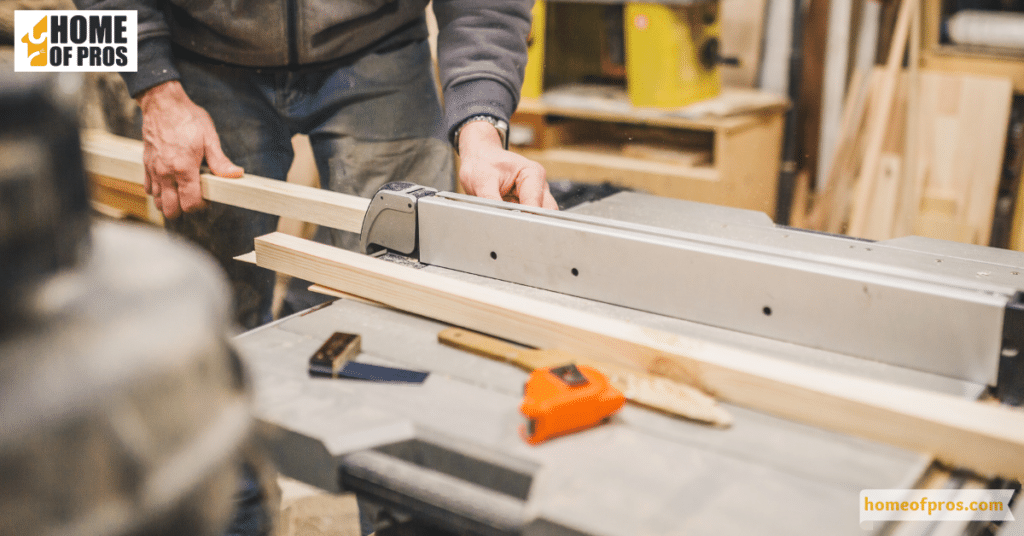Avoid neglecting proper measurements; accurate dimensions are crucial to a successful carpentry project. Don’t overlook safety precautions; always wear protective gear and follow safety guidelines to prevent accidents. Steer clear of rushing through your work; taking your time and paying attention to detail will result in a more polished and professional outcome.
Carpentry plays a vital role in construction and DIY projects. To achieve success and safety, it’s crucial to steer clear of common carpentry mistakes. In this article, we’ll explore the top 10 mistakes that carpenters should avoid, helping you hone your skills and create outstanding projects. Let’s dive in!

1. Neglecting Proper Measurements
Accurate measurements are the foundation of any successful carpentry project. Without precision, errors can quickly compound, leading to wasted materials, time, and frustration. To ensure precise measurements, use quality measuring tools, double-check measurements before making cuts, and take into account the thickness of your saw blade or other cutting tools. Consistency and attention to detail in measurement are keys to avoiding costly mistakes.
2. Ignoring Safety Precautions
Safety should never be underestimated in carpentry. Working with sharp tools and heavy materials presents inherent risks. Neglecting safety precautions can result in serious accidents or injuries.
It’s essential to recognize common safety hazards, such as improper tool usage, inadequate personal protective equipment, or unstable work surfaces. Always prioritize safety by wearing safety gear, keeping work areas clean, and following recommended safety guidelines.

3. Rushing Through the Work
Carpentry is a craft that demands both patience and precision. One of the most common pitfalls in carpentry is the temptation to rush through projects. However, yielding to this urge can result in subpar results and, in some cases, accidents.
To excel in carpentry, it’s crucial to resist the impulse to speed through your tasks. Take the time to plan your work meticulously, ensuring that you have a clear blueprint to follow. Verify your measurements with care, as even a minor discrepancy can lead to significant errors.
4. Using Inadequate Tools
The right tools are the backbone of any successful carpentry project. Using inadequate or outdated tools can hinder the quality and efficiency of your work. Therefore, it is imperative to equip yourself with the appropriate instruments for each specific carpentry task.
Regularly inspect your tools to ensure they are in good working condition, and perform any necessary maintenance promptly. Investing in high-quality tools may initially seem like a significant expense, but it is an investment that pays substantial dividends in the long run.

5. Neglecting Material Selection
In carpentry, the materials you choose are a critical determinant of the final result. Neglecting to consider the suitability of materials for your project’s specific requirements can lead to structural issues and aesthetic disappointments.
To avoid these pitfalls, it’s essential to familiarize yourself with various wood types and their characteristics. Each type of wood has unique properties that make it more or less suitable for different applications. Take the time to research and select the appropriate wood for your project based on factors like durability, appearance, and workability.
6. Lack of Planning and Design
When it comes to carpentry, success begins with a plan. Planning and design are the bedrock of any triumphant carpentry project. Skipping these vital initial steps can lead to confusion, costly mistakes, and project delays down the line.
To avoid these pitfalls, invest your time and effort in creating comprehensive project plans and detailed blueprints. By mapping out your project meticulously, you minimize the chances of unexpected surprises cropping up during construction.

7. Poor Joinery Techniques
In the realm of carpentry, joinery techniques are nothing short of foundational. They play a pivotal role in determining a project’s stability and longevity. Inadequate or incorrect joinery can compromise the structural integrity of your work, resulting in weak connections and potential hazards. To navigate this challenge successfully, take the time to familiarize yourself with various joinery methods and master their execution.
8. Not Considering Environmental Factors
Carpentry projects don’t exist in a vacuum; they interact with the environment around them. Factors like humidity and temperature can significantly impact the outcome of your carpentry endeavors.
Ignoring these environmental elements can lead to problems like warping, cracking, or other structural issues over time. To safeguard your projects from these challenges, it’s crucial to adapt your carpentry techniques and material choices to the specific environmental conditions in which you’re working.

9. Neglecting Finishing and Sanding
These processes are essential for achieving not only a polished appearance but also smooth functionality in your projects. Skipping these crucial steps can result in rough surfaces, uneven finishes, and unsightly imperfections that detract from the overall quality of your work.
To ensure the professional-grade outcome you desire, it’s imperative to become proficient in proper finishing techniques. This involves applying stains, paints, or varnishes with precision and care.
10. Lack of Maintenance and Care
Neglecting this aspect can lead to deterioration and potentially costly repairs in the future. To safeguard your investments and preserve the quality of your work, establish a routine of regular inspections and maintenance. Address any issues promptly, whether it’s a loose joint or a surface in need of refinishing. Applying protective finishes is also crucial in shielding your carpentry from wear and tear.

Conclusion
Avoiding these common carpentry mistakes is vital for achieving successful and satisfying results in your projects. Accurate measurements, safety precautions, patience, proper tools, thoughtful material selection, planning, joinery skills, consideration of environmental factors, finishing, and ongoing maintenance all contribute to the excellence of your carpentry work.
By adhering to these principles, you’ll enhance your craftsmanship and enjoy the rewards of your efforts for years to come.











